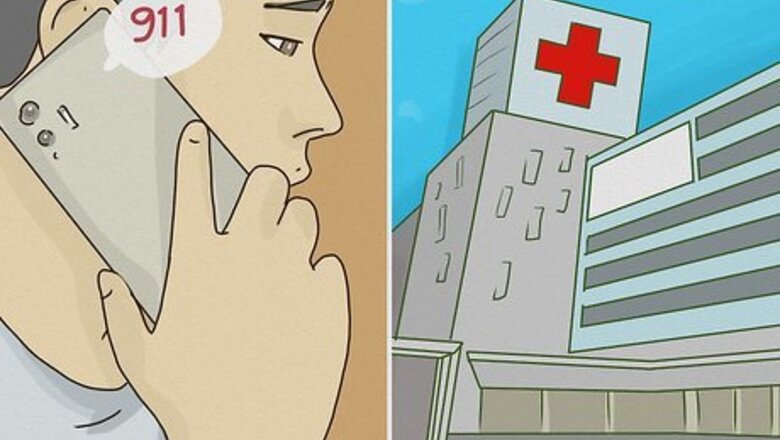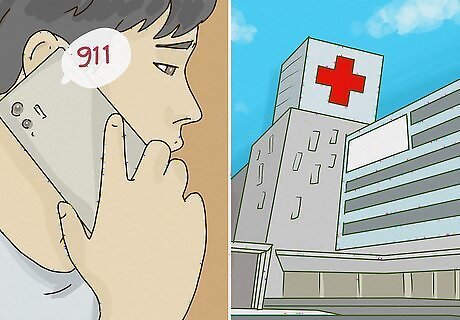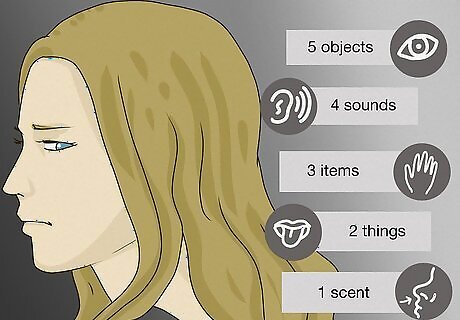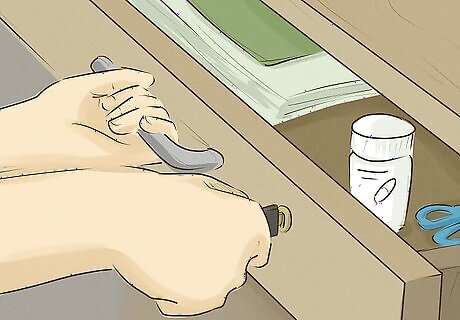
views
Disclaimer: If you’re feeling actively suicidal, call 988 (USA and Canada), 0800 689 5652 (UK), or the suicide prevention hotline or text line for your country.
- Call emergency services or request to be taken to a hospital if you’re feeling actively suicidal.
- Put off any immediate plans to take your own life. You are in control of your own life, and you don’t have to do anything at this moment.
- Ask a friend or loved one to be with you if you don’t feel safe by yourself, or contact a suicide prevention hotline (988 in the US).
Ways to Deal with Suicidal Thoughts

Get to a safe place. Call emergency services or go to a hospital if you think you might harm yourself. Find emergency service and hotline numbers by country here.

Put off any immediate plans. Make a promise to yourself that you’ll wait a set amount of time rather than doing anything in the moment. At the end of the day, you are in control of your life and what comes next—there is no pressure, deadline, or obligation to follow through with any of your thoughts. In 2000, Kevin Hines attempted suicide at the Golden Gate Bridge, but realized immediately after jumping that he didn’t actually want to die. Thanks to the miraculous intervention of a sea lion in the water below, Hines was able to survive and make a full recovery; now, he advocates for suicide prevention. His story (as do many others) shows how immense pain can distort a person’s perceptions in the moment—taking time to wait gives your mind time to clear.

Visualize your friends and loved ones. In the heat of the moment, it’s all too easy to indulge suicidal thoughts. Whenever you’re tempted to give into these thoughts, though, try thinking instead about all the people in your life who love you and would miss you if you weren’t around. No matter how many friends or loved ones you have, your life matters and has an impact on all the people around you, including your neighbors, co-workers, and acquaintances. All of these people would feel a noticeable gap in their life if you weren’t around.

Tell someone exactly how you’re feeling. Use phrases like “I’ve experienced these feelings for a long time…” “I’m considering…” or “Recently, I’ve been struggling with…” to start the conversation. A trusted friend or loved one can help walk you through exactly how you’re feeling and give you valuable advice and pointers on how to move forward. If you aren’t sure who to reach out to, trained counselors are always available if you call your country’s suicide hotline (988 in the US). Free online sources like 7Cups, My Black Dog, and Togetherall are also great places to chat with understanding peers. Never feel embarrassed or “weak” about asking for help. According to psychologist Catherine Boswell, Ph.D, it’s important to realize that “asking for help is a sign of strength and not weakness.” Boswell also suggests viewing your situation in reverse. If someone came and asked you for help, would you judge them? It’s important to extend the same kindness and patience to yourself that you would to others. Sharing your thoughts can be a helpful way to give yourself a reality check, agrees clinical psychologist Urmi Patel, PsyD. By talking it out, you can realize that these thoughts are false, and that ending your life isn’t the right way to resolve whatever issue you’re facing.

Do a grounding exercise to change your mindstate. Staying grounded requires you to focus on specific aspects of your surroundings, which helps you temporarily escape your suicidal thoughts as you center yourself in the here and now. 5-4-3-2-1 exercise: Focus on 5 objects you’re able to see, 4 sounds you’re able to hear, 3 items you’re able to physically feel, 2 things you’re able to taste, and 1 scent you’re able to smell Self-soothing exercise: Engage your physical senses with a variety of enjoyable and comforting activities, like eating your favorite snack, spritzing yourself with your favorite body spray, looking up pictures of beautiful scenery, and so on.

Reframe your thought patterns with positive thinking exercises. If you’re struggling to escape your suicidal thoughts, try guiding your thought patterns in a more positive direction by: Practicing gratitude: List at 3 things that you’re thankful for, even if they seem mundane. Examples: electricity, internet, loving friends, a comfortable bed, etc. Focusing on the positive: Identify at least 3 positive things that happened in the past day, even if they’re simple. Examples: I made time to eat breakfast, I didn’t run into much traffic, I got to see my friend, etc. Adjusting negativity: Identify something negative that happened and think about the positivity that came from it. Example: I overslept my alarm, but was able to get a little extra sleep.

Try mindfully meditating. Mindfulness meditation revolves around relaxing and focusing on the present moment, which can help you break away from negative trains of thought. A great way to mindfully meditate is to sit and focus on your breathing. As you meditate, try to let your thoughts drift by without worrying or stressing about them.

Slow down your breathing. Breathing deeply and slowly can be a great way to ground and separate yourself from your negative thoughts. Give some of these strategies a try, like: 4-5-8 breathing: Inhale through your nose for 4 seconds, hold the breath in your chest for 5 seconds, and then exhale it through your mouth for 8 seconds. Box breathing: Inhale for 4 seconds, hold that breath in your chest for another 4 seconds, and then exhale the breath for 6 seconds. Hold your breath for another 2 seconds, and then repeat the pattern of inhaling, holding, exhaling, and holding for a total of 5-10 minutes. Slow breathing: Get comfortable, close your eyes, and pay close attention to the way you’re breathing. Identify the way the breath travels throughout your body, slowing down your breath as you go.

Try doing a distracting activity to get your mind off things. Any type of positive distraction can be helpful when you’re struggling with suicidal thoughts, whether that’s walking around your neighborhood, rewatching your favorite TV show, or doing some arts and crafts. You could also: Play games built into the Google search engine, like Solitaire, Snake, or Pac-Man Cook/bake a new dish Use Google’s digital coloring book Eat at your favorite restaurant Reread a favorite book that brings you comfort Go on a road-trip Hang out with your dog in the park
How to Stay Safe and Get Help
Call 988 (in the US) for immediate support if you’re feeling suicidal. You don’t have to deal with your suicidal thoughts alone—trained counselors are ready and waiting to support you during this difficult time. If your life is actively in danger, call emergency services right away.

Get rid of any items that can be used for self-harm. Toss out, lock away, or otherwise secure items that you could use to hurt yourself, like knives, firearms, and medications. If you don’t want to get rid of the items altogether, ask a trusted friend or loved one to hang onto them until a later time.

Ask a friend or loved one to come over and be with you. Let them know that you’re feeling unsafe and that you’d really like to be around another person at the moment. If you don’t feel comfortable contacting a friend or family member, reach out to a counselor by calling 988 (or your country’s respective suicide hotline).

Avoid using drugs or alcohol as a coping mechanism. Alcohol and drugs might seem like a good way to cope in the moment, but they’ll leave you feeling even more negative and hopeless in the long run.

Stay away from anything that could further trigger you. Make a list of things that tend to make you feel even more sad and negative, like depressing music or memorabilia of a deceased friend/loved one. It also helps to stay away from triggers like: Books, movies, and music with dark themes Stressful situations Being alone
Long-Term Coping Strategies

Create a safety plan for yourself to follow in the future. A safety plan is a personal toolkit that helps you identify when you’re in a suicidal headspace and know what to do moving forward. A safety plan can include: A list of signs that you’re in a bad headspace (spiraling thoughts, suicidal ideation, etc.) Contact information for people you can reach out to (e.g., friends, loved ones, healthcare professionals, etc.) Phone numbers for different helplines and text lines Ways to stay safe if you’re feeling suicidal

Craft a crisis box for yourself. A crisis box (or “hope box”) is filled with items that help you feel better during a rough time. Stick items in your crisis box that speak to the different senses, like a photo of you and your friends, a scented candle, your favorite candy, and/or a fidget toy. Whenever you’re struggling with suicidal thoughts, use this box as a source of comfort. Your crisis box doesn’t actually have to be a box—it can be a tin, gift bag, or any other vessel that works for you. Feel free to personalize your crisis box however you’d like.

Create and follow a scheduled routine for yourself. Following a set schedule can help you feel grounded and in control, even if your suicidal thoughts are making you feel off-kilter. Fill this schedule with necessary, non-negotiable tasks that you complete each day, like eating breakfast, brushing your teeth, going for a walk, and/or drinking a cup of tea. Clinical psychologist Urmi Patel, PsyD explains how the key reason someone might take their life “has to do with the feeling of hopelessness or not truly believing that there’s a way out.” She emphasizes how it’s important to break down all the different things you do in a day, like brushing your teeth or having a cup of coffee, and identify all the times you chose to live and move forward (and why that’s the case).

Break your struggles down into smaller, more manageable tasks. Identify a major problem and why it’s causing you stress. What steps can you take to approach this problem in a more reasonable and manageable way? Breaking down the problem can make it easier deal with, and may help improve your frame of mind. Example: If you’re worried about a large, upcoming bill, see if there’s a way to defer the payment or split it up into smaller payments.

Get a little exercise. Go for a walk, play a pick-up game of soccer with some friends, or even dance around your bedroom—anything that gets you moving can help you feel a little more positive and uplifted. Aim to exercise for around 30 minutes each day (or in shorter, 10-minute chunks if that feels more manageable).

Fill your life with fulfilling activities and hobbies. Even if you aren’t in the best headspace now, think about the hobbies that made you happy in the past. Look for ways to sprinkle these activities into your day-to-day life, even if you don’t have the motivation at first. If you used to do community service, look for ways to volunteer in your local community (like helping at a local food bank).

Cultivate more self-love in your life. Focus on altering your negative thought patterns and realizing the negative thoughts are not true. To start relieving the pain of your negative feelings, it’s important to be kind to yourself and see yourself as a strong person who is persevering. Myths about suicide, such as the idea that it's a selfish act, are perpetuated by many cultures, causing people who have suicidal thoughts to feel guilty or ashamed on top of the negative feelings they're already burdened with. Learning how to separate these myths from reality can help you cope better with your thoughts.

Join a mental health support group. Support groups can be a great way to connect with other people who have lived through similar feelings and experiences. To find a support group near you, check out resources like: NAMI (US) MHA National (US) Rethink (UK)

Meet with a mental health professional. Getting professional support is nothing to be ashamed of—it proves that you’re strong enough to ask for help, and that you care enough about your well-being to take extra steps to feel better. Click here to find a therapist in your area (US only). There are a lot of promising therapies designed for people who struggle with suicidal thoughts and ideation, including Dialectical Behavioral Therapy (DBT) and Cognitive Behavior for Suicide Prevention (CBT-SP). Working with a mental health professional can help you uncover some of the reasons behind your suicidal thoughts. As you find ways to address these issues, you’ll likely feel better over time.




















Comments
0 comment